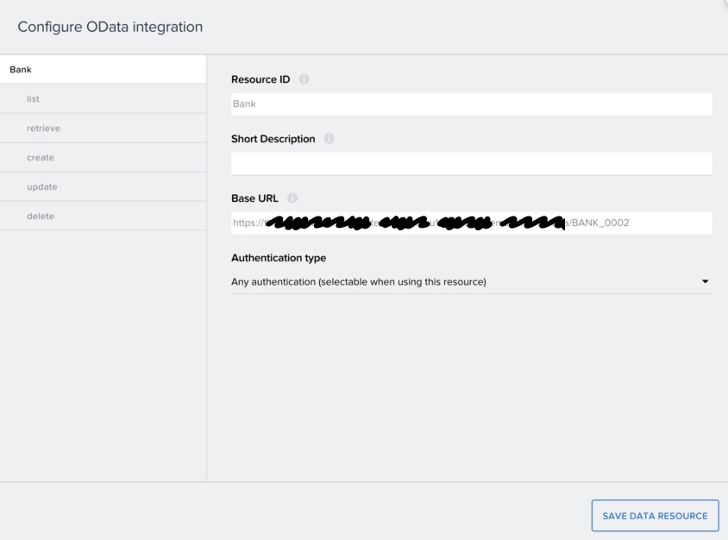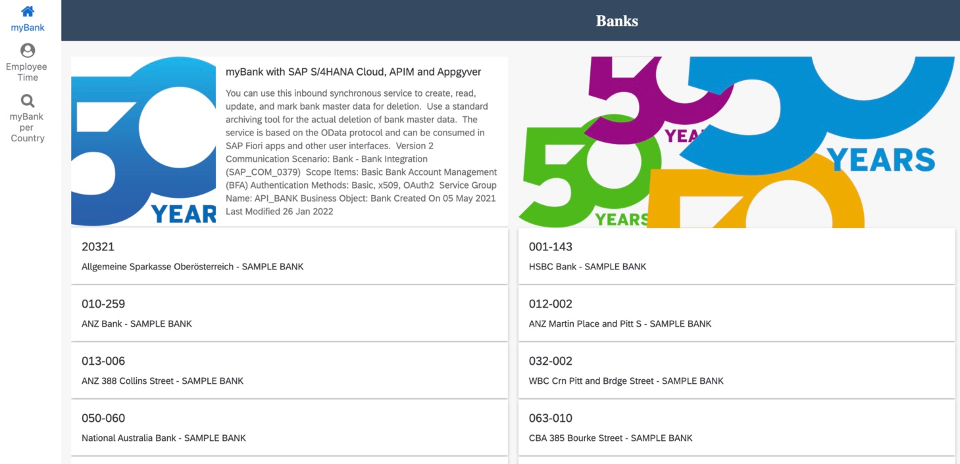
- SAP Community
- Products and Technology
- Enterprise Resource Planning
- ERP Blogs by SAP
- myBank with SAP S/4HANA Cloud, APIM and Appgyver
Enterprise Resource Planning Blogs by SAP
Get insights and updates about cloud ERP and RISE with SAP, SAP S/4HANA and SAP S/4HANA Cloud, and more enterprise management capabilities with SAP blog posts.
Turn on suggestions
Auto-suggest helps you quickly narrow down your search results by suggesting possible matches as you type.
Showing results for
Product and Topic Expert
Options
- Subscribe to RSS Feed
- Mark as New
- Mark as Read
- Bookmark
- Subscribe
- Printer Friendly Page
- Report Inappropriate Content
03-31-2022
4:07 PM
 | This brief is to showcase how one can implement access to any inbound ODATA or REST API by leveraging SAP Appgyver's intrinsic Data integration capabilities. We shall see how this can be done using the BANK_0002 API (S4HC) against a productive S/4HANA Cloud system. |
Pre-requisites:
Good to know:
Disclaimer:
|
Before we start...
An aerial view of S/4HANA Cloud APIs.
 | With a whooping [...] and counting business APIs, there is an ever growing number of these APIs that support the principal business user propagation out-of-the-box. (this is with either OAuth2SAMLBearerAssertion or SAMLAssertion authentication flows) |
Good to know:
- However, even if the above still does not hold true for all the APIs, quite a large number of APIs supports x509 client certificate authentication (albeit with regard to a communication user).
- At present, the customer influence portal is conducting a S/4HANA Cloud campaign focused on the APIs without any upvoting threshold, namely https://influence.sap.com/sap/ino/#/campaign/1175
Let's have a look at the line-up of the S/4HANA Cloud APIs on SAP_API_BUSINESS_HUB .
Good to know: As the SAP API Business Hub offers its own ODATA catalog service we shall be using it for APIs browsing and discovery as follows:
Additionally, the APIs can be broken down by subtype as follows:
Q: Is there an easy way to know what authentication methods are supported, what communication scenario are involved, etc ?
A: Indeed, it is fairly easy to [programmatically] retrieve a given API characteristics merely by its catalog name...for instance:
With merely knowing the name of an API the API definition can be looked up on API Business Hub as follows: https://api.sap.com/api/{<Name>}/overview,for instance, https://api.sap.com/api/BANK_0002/overview Likewise is the possible to retrieve an openapi definition by its mere name, in either json or yaml format, as follows:
|
Putting it all together.
Step1. The communication arrangement (S/4HANA Cloud)
Let's create a new communication arrangement based on the Bank Integration communication scenario for the following API, namely BANK_0002
Please refer to the following gist for further details.
Step2. myBank API proxy (SAP API Management)
Let's implement S/4HANA Cloud myBank API with the OAuth2SAMLBearerAssertion flow by leveraging API Management.
The end game is to be able to fetch the EDMX metadata using the API Proxy URL below:
https://<API Proxy hostname>/***/BANK_0002/$metadataGood to know:
- myBank API proxy has a built-in CORS policy where additional headers can be added or removed
Please refer to the following gist for further details.
Step3. Create a front end web application (SAP Appgyver)
SAP Appgyver offers a so-called "zero lock-in" approach to data. In other words your data never hits Appgyver backend servers.
All you need to do is to expose your backend functionality with either ODATA or REST APIs.

 |  |  |
and voila...

Please refer to the following gist for further details.
Conclusion.
Last but not least, I hope you enjoyed reading this blog. Please provide your feedback in the comments section below.
Appendix
A case for SAP API Management as a framework to implement your extensions with S/4HANA CloudQ. What is the key advantage of using SAP API Management (APIM) to implement extensions with S/4HANA Cloud ? A. There are several ones.
|
Additional resources

- SAP Managed Tags:
- API Management,
- SAP Build Apps
Labels:
3 Comments
You must be a registered user to add a comment. If you've already registered, sign in. Otherwise, register and sign in.
Labels in this area
-
Artificial Intelligence (AI)
1 -
Business Trends
363 -
Business Trends
23 -
Customer COE Basics and Fundamentals
1 -
Digital Transformation with Cloud ERP (DT)
1 -
Event Information
461 -
Event Information
24 -
Expert Insights
114 -
Expert Insights
158 -
General
1 -
Governance and Organization
1 -
Introduction
1 -
Life at SAP
415 -
Life at SAP
2 -
Product Updates
4,684 -
Product Updates
218 -
Roadmap and Strategy
1 -
Technology Updates
1,502 -
Technology Updates
89
Top kudoed authors
| User | Count |
|---|---|
| 13 | |
| 11 | |
| 10 | |
| 7 | |
| 7 | |
| 6 | |
| 6 | |
| 4 | |
| 4 | |
| 4 |

